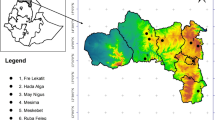Abstract
Recent droughts in the humid southeastern United States have focused attention on the need for and use of supplemental irrigation. Total annual rainfall amounts are sufficient for most crops in the region. However, erratic distribution of rainfall and the low water-holding capacities of most soils in the region cause frequent drought stresses in many crops. An on-farm study was conducted in southeastern Alabama to evaluate the effects of farmers' irrigation scheduling decisions on soil moisture variations in peanut fields irrigated with center-pivot irrigation systems. The study showed that the way irrigation was practiced in this high rainfall area often caused soil moisture deficit (SMD) level higher than the desired SMD limit during over 20% of the 140-day growing season. This is partially due to farmers' tendency to delay irrigation in anticipation of rainfall which may or may not occur, as rainfall during the growing season is often erratic and local. In contrast SMD in non-irrigated fields was higher than the SMD limit for half of the growing season.
Similar content being viewed by others
Abbreviations
- SMD:
-
soil moisture deficit
- ET:
-
evapotranspiration
- Reff :
-
effective rainfall
- WHC:
-
water holding capacity
References
Bruce R.R., Chesness J.L., Keisling T.C., Pallas, Jr J.E., Smittle D.A., Stansell J.R. & Thomas A.W. 1980. Irrigation of Crops in the Southeastern United States: Principles and Practices. USDA-ARS. New Orleans, La. ARM-S-9.
Camp C.R. & Campbell R.B. 1988. Scheduling Irrigation for Corn in the Southeast. ARS Series No. 65. Agr. Res. Service, USDA, Washington, D.C.
Camp C.R., Sadler E.J., Sneed R.E., Hook J.E. & Ligetvari F. 1990. Irrigation for humid areas. In: Hoffman G.J., Howell T.A. & Soloman K.H. (Eds) Management of Farm Irrigation Systems. Chapter 15. ASAE, Monograph. St. Joseph, MI.
Doty C.W., Camp C.R. & Christenbury G.D. 1982. Scheduling irrigation in the southeast with a screened evaporation pan. In: Proc. Specialty Conf. on Environmentally Sound Water and Soil Management, ASCE (pp 475–483). New York, NY.
Lambert J.R. 1980. Irrigation management — humid areas. In: Proc. of the 2nd Natl. Irrigation Symposium. Irrigation Challenge of the 80's. ASAE, Pub. 6-81 (pp 175–184). St. Joseph, MI.
Lambert J.R., Israel I. & Meirson I. 1988 Computer program for scheduling irrigation by water budget. In: Scheduling Irrigation for Corn in the Southeast. Camp C.R. & Campbell R.B., Coordinators. Chapter 2. ARS Series No. 65. Agr. Res. Service, USDA, Washington, D.C.
Lundstrom D.R., Stegman E.C. & Werner H.D. 1981. Irrigation scheduling by the checkbook method. Proc. Irrigation Scheduling for Water and Energy Conservation in the 80's. ASAE Spec. Pub. 23-81 (pp 187–193). St. Joseph, MI.
Martin D.L., Stegman E.C. & Fereres E. 1990. Irrigation scheduling principles. In: Hoffman G.J., Howell T.A. & Soloman K.H. (Eds) Management of Farm Irrigation Systems Chapter 7. ASAE, Monograph. St. Joseph, MI.
Rhoads F.M. & Stanley, Jr R.L. 1978. Effect of population and fertility on nutrient uptake and yield components of irrigated corn. Soil and Crop Soc. (Florida) 38: 78–81.
Rochester E.W. & Busch C.D. 1972. Scheduling model which incorporates rainfall predictions. Water Resour. Bull. 8(3): 608–613.
Rochester E.W., Backman P.A., Mcguire J.A., Curtis L.M., Starling J. & Ivey H. 1984. Irrigation schedules for peanut productio. Alabama Agricultural Experiment Station, Auburn University. Bulletin 556. Auburn, AL.
Stansell J.R., Shepherd J.L., Pallas J.E. & Bruce R.R. 1976. Peanut response to soil water variables in the Southeast. Peanut Science 3(1): 44–48.
Stockle C.O. & Dugas W.A. 1989. Effect of weather variability and precipitation uncertainty on grain sorghum irrigation scheduling. Transactions of the ASAE 32(6): 1939–1943.
Tyson T.W. & Curtis L.M. 1990. Scheduling irrigation in the Southeast with minimum inputs. In: Proc. The Third National Irrigation Symposium: Visions of the Future. ASAE, Pub. 04-90 (pp 688–691). St. Joseph, MI.
United States Soil Conservation Service. 1974. Chapter 1. Soil-plant-water relationship. In: SCS National Engineering Hand Book. Section 15 Irrigation. U.S. Government Printing Office. Washington, D.C.
Villalobos F.J. & Fereres E. 1989. A simulation model for irrigation scheduling under variable rainfall. Transactions of the ASAE 32(1): 181–188.
Von Bernuth R.D., Martin D.L., Gilley J.R. & Watts D.G. 1984. Irrigation system capacities for corn production in Nebraska. Transactions of the ASAE 27(2): 419–424.
Westesen G.L. & Hanson T.L. 1981. Irrigation scheduling using washtub evaporation pans. In: Proc. Irrigation Scheduling for Water and Energy Conservation in the 80's. ASAE Spec. Pub. 23-81 (pp 144–149). St. Joseph, MI.
Author information
Authors and Affiliations
Rights and permissions
About this article
Cite this article
Yoon, K.S., Yoo, K.H., Tyson, T.W. et al. Farmers' irrigation practices in a high rainfall area. Irrig Drainage Syst 7, 221–229 (1993). https://doi.org/10.1007/BF00881281
Received:
Accepted:
Issue Date:
DOI: https://doi.org/10.1007/BF00881281




